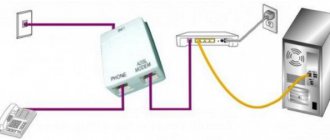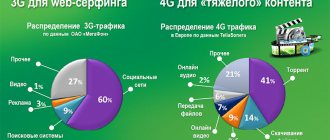Internet in a private home: wired and wireless connection options
Internet access to a private home is provided in different ways. You can stretch an optical cable or connect via a cellular operator modem. And if you install a router indoors, you can get high-speed Internet in a private home on all mobile gadgets. People use high-speed Internet every day. Going online is necessary not only for communication and entertainment.
Through the Internet in the cottage you can solve important work issues and conduct business. The global network allows you to receive education remotely. This is an immense field of possibilities that has no boundaries. But what type of Internet is suitable for a private home?
What does an Internet cable look like and how to distinguish it from SIP
First, let's learn how to distinguish optical cables from electrical cables. The main difference is the way the cable is attached to the support.
Fastening a 10kV cable to a support
fastening the SIP cable to the support
Attaching the optical cable to the support
The next difference is the presence of couplings or ORK (optical distribution box) on the optics.
Optical coupling on lighting pole
Technologies for connecting via telephone lines
Dial-Up technology was once popular. It is considered obsolete, but still continues to be used in some areas. The subscriber receives Internet for the dacha through telephone lines. When the Internet first began to spread, subscribers were connected to a modem combined with a telephone cable.
There is only one advantage of this method - you can use the existing infrastructure. There are many more disadvantages. During the session, the subscriber cannot use a landline telephone. Data transfer speed is only 56 Kbps. For users of the 21st century, this figure will seem ridiculous.
The technology is rarely used. Dial-Up connection exists in remote areas. Subscribers have to use it due to the lack of alternatives.
The second type of connection via a telephone line is more advanced - ADSL. In this case, telephony is also taken as a basis, but the speed indicator is much higher. It is possible to install an ADSL splitter. Subscribers get the opportunity to simultaneously use the Internet and telephone.
At a certain time, ADSL Internet broke all records for the number of connections. But today the technology is considered obsolete. In megalopolises and large cities of the region it is practically not used. Dial-Up and ADSL technologies have been replaced by fiber optic communication lines.
Laying an optical cable in the ground
Trunk optical cables are often laid in the ground; for this purpose, a trench with a depth of 0.6 to 1.2 meters is dug. The cable used is a special armored one, which is not so easy to cut. Such highways are usually built along highways and power lines.
column Megafon
Rostelecom and Megafon mark such cables with special posts. It is common to see emergency couplings lying on the ground unattended. This is of course wrong, they should be in the wells, but during urgent emergency work, when everything needs to be done quickly, they don’t think about such trifles. And then somehow it is forgotten.
otic coupling in the forest
This cable laying technology is rarely used in residential areas because... A cable lying in the ground is inconvenient to maintain.
Optical fiber
The perfect technology that can be used to provide the population with high-speed connectivity is FTTx. This type of organization assumes that the main part of the line is optical, and the distribution part is copper (or also optical). Based on what type of cable will be pulled into the apartment, equipment is selected. Routers choose optical or Ethernet.
Optical cable is very expensive. It consists of glass or plastic. Data passes through it at high speed. The light signal provides such a high speed indicator. Despite traveling long distances, the signal is not lost or weakened.
Copper cable is more susceptible to electromagnetic interference. Therefore, signals may fade. For twisted pair cables, you need to use special buffers or correctors. This ensures proper protection. Providers use the following scheme: optical fiber from the service provider is carried out to an apartment building, and a twisted pair cable is installed in each apartment.
Most wired Internet providers offer customers unlimited tariffs. In this case, the data transfer rate can exceed one hundred megabits per second.
Another technology based on Ethernet is GPON. This is a gigabit passive optical network. According to this scheme, the service provider directly runs a fiber optic cable into the subscriber's apartment. The technology provides users with Internet at ultra-high speeds. The speed indicator can reach thousands of gigabits per second.
This technology is not yet available to everyone. The service is expensive. A leased line allows subscribers to enjoy a stable connection. You can hold online conferences, watch movies without freezing, and download large files. Many providers offer clients to connect IP television and telephony in parallel.
Placement of optics in the cable duct
In large cities, such as St. Petersburg, most of the optics are stored in cable ducts. Most of these sewers were built during the Soviet era and now they belong to PJSC Rostelecom. But not always and not everywhere, for example, on the territory of factories, sewerage was privatized by the plant. Cable ducts can be easily identified by the inscriptions on the hatch - GTS or City Telephone Network.
We are not surprised, the Internet appeared much later than the telegraph and telephone. It was for them that the cable duct was originally built. Nowadays, an optical cable is capable of transmitting all types of signals, but even new hatches are still marked with such symbols.
laying optics in the sewerage of St. Petersburg
It is important to understand that if an Internet provider wants to place its cables in the sewer of the same Rostelecom, it must pay for it monthly. But placing the cable in this way is as reliable and safe as possible. The optical cable itself for placement in a sewer is on average cheaper than for suspension or placement in the ground.
Cable drainage for optics in one of the cottage villages
An important detail is how the cable exits the sewer and enters your home. If a cable entry was not organized during the construction of the house (usually a PVC pipe protruding from the foundation), then it will have to be organized from scratch, and this is an additional cost and sometimes considerable.
Multi-colored plastic tubes are sewage
In modern cottage villages, cable drainage for low-current wiring is laid at an early stage of construction. This greatly simplifies connecting the cottage community to the Internet.
Wireless Internet in a private home
How to connect the Internet in a private home if there is no cable provider? Sometimes providers refuse to connect to residents of the private sector. Most often, fiber optic Internet is not suitable for a country house or cottage. If there is no technical ability to connect a home via ADSL or fiber, people choose WiMax, Wi-Fi and cellular operator networks.
Access to the network is provided by a wireless modem. Internet to the home without wires is often of interest to residents of the private sector, country and cottage villages. In many villages they choose this connection scheme. Wireless Internet is cheap.
The data transfer speed directly depends on the selected connection technology. In 4G mobile networks, speeds can reach one hundred megabits per second. Mobile Internet can be used wherever there is adequate network coverage. The speed indicator will be affected by the distance to the nearest base station. If at a dacha or in a country house the signal is weak and unstable, you can install special amplifier antennas.
Companies offer sets of amplification equipment. These devices make the signal fast and reliable.
WiFi
In addition to paid options, Rostelecom also provides its subscribers with free Internet use through the distribution of a public Wi-Fi signal. According to the government program “Eliminating the Digital Divide,” adopted in 2003, Wi-Fi routers should be installed in settlements whose population varies from 250 to 500 people, to which anyone can connect.
The connection speed of such a network is 10 Mbit per second, however, due to the large connection to one Wi-Fi source, the signal can be significantly reduced. At the moment, many settlements have already been connected.
Alternative connection methods
A less common way to connect to the Internet is DOCSIS technology. The essence of the technique comes down to data transmission via a coaxial cable. It is used to organize television in houses and apartments. In this case, the subscriber will need to install a special modem. It will separate signals for TV and Internet.
The data transfer speed via DOCSIS does not exceed forty megabits per second. If your cable TV provider offers to immediately connect to the Internet, you can save money.
The second alternative is to install a satellite dish. The technique is relevant only if the private house is located in the middle of nowhere. If it is not possible to connect optical fiber and mobile Internet, subscribers prefer satellite technologies. In addition to the satellite dish, the user will have to purchase a set of special equipment. The cost of such a set is impressive.
To make access two-way, you need to order a special satellite modem. The speed indicator can reach twenty megabits per second. The disadvantage of satellite technology is the high cost of equipment and subscription fees. Not everyone can handle the installation and settings of devices, so you will have to call a specialist. The only advantage of satellite Internet is the ability to connect anywhere in the world.
How to install Internet at your dacha
To choose the right connection method, you need to understand your own needs. Consider your financial capabilities. You also need to take into account the technical capabilities for a particular connection option. The most popular option for city apartments is a leased line. Providers offer many competitive rates.
But this proposal is not relevant for owners of suburban real estate. Mobile data transfer is suitable for them.
The mobile connection will be enough for:
- work tasks;
- online learning;
- watching films and TV series;
- listening to music;
- surfing;
- communication on social networks and instant messengers.
Wired Internet is rarely connected outside the city. Therefore, you have to choose one of the alternative options. The easiest way is a wireless connection. If the house is located far from cell towers, you need to install amplifying equipment.
How to leave a request and connect?
The easiest way to apply for an Internet connection, as well as other communication services, is on the official portal of the provider. Enough:
- Select a region from the list.
- Go to the “Internet” subsection.
- Check out the options and click on the one you like the most.
The system will display an online application dialog. You must fill it out, indicating your contacts, address and full name, and click the “Connect” button. After some time, the company manager will call you. If this method is inconvenient for you for some reason, you can leave a request for connection at any office of the company.
Top Service Providers
The level of service provider companies varies. Large providers serve almost the entire population of Russia. The leader in the number of clients will be eliminated by the largest.
The Big Three operators are not far behind:
- MTS;
- Megaphone;
- Beeline.
Every company strives to attract as many customers as possible. To achieve this, profitable promotions are constantly being held and new tariff plans are being developed.
Rostelecom
The Russian telecommunications company offers clients a lot of services:
- telephony;
- optical internet;
- xDSL;
- wireless technologies Wi-Fi, WiMax;
- LTE mobile networks;
- interactive TV;
- video surveillance systems;
- cloud services;
- payment services.
Residents of all regions of Russia use the services of Rostelecom. The provider provides a stable and stable connection. You can choose tariff plans to suit any budget. The company regularly holds promotions and makes lucrative offers to customers. The minimum subscription fee is two hundred rubles.
Mobile operator MTS
The Russian cellular operator is a home Internet provider.
In addition, the company connects television to houses and apartments:
- cable;
- digital;
- satellite;
- mobile.
MTS communications are popular in GSM, UMTS (3G) and LTE standards. The subscription fee for home Internet starts from four hundred rubles. Thanks to its wide geographical coverage, MTS services can be used by residents of all regions of the Russian Federation. The operator offers a diverse range of tariff plans. You can study the company's offers in detail on the official website.
Mobile Internet
If the subscriber uses exclusively portable devices (mobile phones, tablets and other gadgets), then it is more advisable not to connect the Internet through expensive fiber-optic networks or telephone communications.
An excellent option may be to use a mobile connection - without a home phone. Sim cards will cost users much less than other methods of connecting to the World Wide Web.
Tariff plans from Rostelecom offer their customers Internet traffic from 70 megabytes to 25 gigabytes per month. The price category of tariffs will differ depending on the amount of Internet data provided.
However, before choosing traffic, you should pay more attention to the components of the tariff plan. Some tariffs from Rostelecom still use exclusively 3G communications, ignoring the more advanced LTE 4G.









